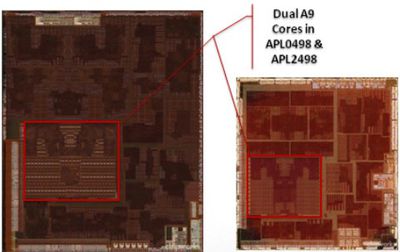Apple TV's A5 Chip Includes Surprise Die Shrink to 32nm [Updated: Same Chip Found in iPad 2]
While the new 1080p-capable Apple TV has been available for nearly a month, Chipworks has now gotten around to tearing down the device's custom A5 system-on-a-chip, discovering with some surprise that the chip is actually a new design from Apple using a die shrink from the 45-nm process used in the A5 of the iPhone 4S to a new 32-nm process. The teardown also reveals what many had suspected: that the "single-core" A5 advertised by Apple for the new Apple TV is actually a standard dual-core chip with one of its cores disabled.
The new A5 processor die is not a single core processor, but contains a dual core processor. Either Apple is only utilizing one core or they are binning parts. Parts binning is a common process in semiconductors where devices are segregated (binned) based on meeting a subset of the overall requirements, in this case they could disable the “bad” core, this increases the usable die per wafer, lowering the cost.
As for the die shrink on the Apple TV's A5, the development raises question about why Apple made the investment in such changes to the A5 for a relatively low volume device like the Apple TV. Despite the benefits of a die shrink, the cost of implementing it for the Apple TV alone would not be inconsequential.
 Dual ARM cores from iPhone 4S A5 chip (left) and Apple TV A5 chip (right)
Dual ARM cores from iPhone 4S A5 chip (left) and Apple TV A5 chip (right)The new A5 measures nearly 41% smaller than its predecessor, coming in at 69.6 mm². Process shrinking not only reduce costs by fitting more dies on a wafer, but it also improves performance and lowers power consumption. This is a very complex chip for a relatively low volume part (for Apple); one would think they have greater plans for this new A5 variant.
Even the A5X used in the new iPad is manufactured using 45-nm processes, making the Apple TV the company's first iOS device to move to the smaller and more efficient 32-nm process.
Update: Chipworks has now updated its report to note that the 32-nm A5 is also showing up in the latest models of the iPad 2. The observation makes it clear that Apple is using the lower-volume models as a testing ground for the more efficient 32-nm processes, with fully-functional dual-core chips landing in the iPad 2 while the Apple TV receives single-core chips with either one core intentionally disabled or one defective core.
(Thanks, @anexanhume!)
Popular Stories
Apple previously announced that a public beta of iOS 26 would be available in July, and now a more specific timeframe has surfaced.
Bloomberg's Mark Gurman today said that Apple's public betas should be released on or around Wednesday, July 23. In other words, expect the public betas of iOS 26, iPadOS 26, macOS 26, and more to be available at some point next week.
Apple will be releasing...
We may finally have a definitive list of all color options for the iPhone 17 series, ahead of the devices launching in September.
MacRumors concept
In a report for Macworld today, Filipe Espósito said he obtained an "internal document" that allegedly reveals all of the color options for the upcoming iPhone 17, iPhone 17 Air, iPhone 17 Pro, and iPhone 17 Pro Max models.
The report includes ...
The long wait for an Apple Watch Ultra 3 is nearly over, and a handful of new features and changes have been rumored for the device.
Below, we recap what to expect from the Apple Watch Ultra 3:Satellite connectivity for sending and receiving text messages when Wi-Fi and cellular coverage is unavailable
5G support, up from LTE on the Apple Watch Ultra 2
Likely a wide-angle OLED display that ...
Apple's next-generation iPhone 17 Pro and iPhone 17 Pro Max are only two months away, and there are plenty of rumors about the devices.
Below, we recap key changes rumored for the iPhone 17 Pro models.
Latest Rumors
These rumors surfaced in June and July:A redesigned Dynamic Island: It has been rumored that all iPhone 17 models will have a redesigned Dynamic Island interface — it might ...
A new Apple TV is expected to be released later this year, and a handful of new features and changes have been rumored for the device.
Below, we recap what to expect from the next Apple TV, according to rumors.
Rumors
Faster Wi-Fi Support
The next Apple TV will be equipped with Apple's own combined Wi-Fi and Bluetooth chip, according to Bloomberg's Mark Gurman. He said the chip supports ...
Apple today said its store at the Westfield Hornsby shopping mall, in Hornsby, Australia, will be permanently closing in October.
Apple Hornsby
In a statement shared with Australian tech news website EFTM (via Reddit), Apple said that it has decided not to renew its lease at Westfield Hornsby. Apple said all affected retail employees will be given the opportunity to work at Apple's nearby...
Apple will launch its new iPhone 17 series in two months, and the iPhone 17 Pro models are expected to get a new design for the rear casing and the camera area. But more significant changes to the lineup are not expected until next year, when the iPhone 18 models arrive.
If you're thinking of trading in your iPhone for this year's latest, consider the following features rumored to be coming...





















